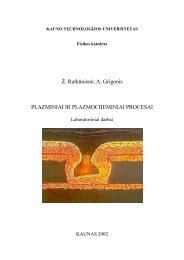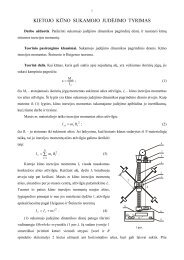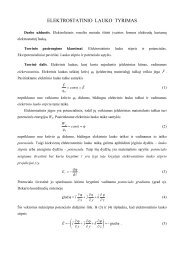PROCEEDINGS OF THE 7 INTERNATIONAL ... - Fizika
PROCEEDINGS OF THE 7 INTERNATIONAL ... - Fizika
PROCEEDINGS OF THE 7 INTERNATIONAL ... - Fizika
You also want an ePaper? Increase the reach of your titles
YUMPU automatically turns print PDFs into web optimized ePapers that Google loves.
Intensity, (a.u.)<br />
200<br />
190<br />
180<br />
170<br />
160<br />
150<br />
J. Laurikaitienė et al. / Medical Physics in the Baltic States 7 (2009) 117 - 120<br />
No. 5 after irradiation (D=2 Gy)<br />
140<br />
1100 1200 1300 1400 1500 1600 1700 1800<br />
Intensity, (a.u.)<br />
30<br />
24<br />
18<br />
12<br />
6<br />
0<br />
Raman shift, cm -1<br />
No. 5 after irradiation (D=8 Gy)<br />
1000 1100 1200 1300 1400 1500 1600 1700 1800 1900 2000<br />
Raman shift, cm -1<br />
Fig. 3. Raman spectra of DLC film No. 5 after 2 Gy and<br />
8 Gy irradiation<br />
In contrariety, the intensity ratio ID/IG has a tendency to<br />
increase for the irradiated sample series 1G (Fig. 4). An<br />
increase in ID/IG ratio is related to the increase in the<br />
number and/ or size of sp 2 clusters [15]. As it was<br />
shown in [16, 17] the increase in ID/IG ratio and G shift<br />
towards higher wave number are associated with a<br />
decrease both sp 3 content and optical gap energy of<br />
a-C:H films, i.e. progressive graphitization of C takes<br />
place after irradiation of the films. The same tendency<br />
for G and D peaks, and ID/IG ratio variation was<br />
described in [18] and [19] studies. It was shown hat the<br />
shift of G and D peaks to upwards and increasing<br />
intensity of D peak indicates a severe degradation of the<br />
structural properties of the films, i.e. decrease of the sp 3<br />
content.<br />
To bring the obtained information about the influence of<br />
X-ray irradiation on the structural changes in DLC films<br />
up-to-date, FTIR transmittance and reflectance spectra<br />
were investigated. Peaks around 2850 and 2920 cm −1<br />
corresponding to the sp 3 CH2 symmetric and<br />
asymmetric stretching modes, respectively, were found<br />
as it is usual for a-C:H films. The strong absorption at<br />
1640 cm −1 was attributed to the presence of sp 2 C C<br />
bond, while peak at 1730 cm −1 was assigned to the C O<br />
valence vibrations. Broad low intensity band observed<br />
in the range of 3200–3400 cm −1 defined sp1 OH<br />
stretching vibrations (Fig. 5). Only few differences in<br />
the peak areas were found in measured IR spectra of the<br />
irradiated samples as compared to the initial samples.<br />
119<br />
Intensity, (a.u.)<br />
Intensity, (a.u.)<br />
Intensity, (a.u.)<br />
4<br />
3<br />
2<br />
1<br />
0<br />
No. 1G before irradiation<br />
1250 1300 1350 1400 1450 1500 1550 1600 1650<br />
Raman shift, cm -1<br />
280 No. 1G after irradiation (D=2 Gy)<br />
275<br />
270<br />
265<br />
260<br />
255<br />
250<br />
245<br />
240<br />
235<br />
1100 1200 1300 1400 1500 1600 1700 1800<br />
30<br />
25<br />
20<br />
15<br />
10<br />
5<br />
Raman shift, cm -1<br />
No. 1G after irradiation (D=8 Gy)<br />
0<br />
1100 1200 1300 1400 1500 1600 1700 1800<br />
Raman shift, cm -1<br />
Fig. 4 Raman spectra of DLC No. 1G before and after 2<br />
Gy and 8 Gy irradiation fractions)<br />
In general, most significant changes in the bonding<br />
structure after the irradiation was observed in less dense<br />
and highly hydrogenated (H content >30at %) samples<br />
The structure and surface morphology of the DLC films<br />
with well developed networking structure remained<br />
almost the same after their irradiation making them<br />
most promising for their application as protective<br />
coatings in the construction of optical devices.<br />
R, %<br />
99,0<br />
98,5<br />
98,0<br />
97,5<br />
97,0<br />
96,5<br />
96,0<br />
95,5<br />
95,0<br />
94,5<br />
94,0<br />
1636<br />
1873<br />
1736<br />
2852<br />
1500 2000 2500 3000 3500 4000<br />
ν, cm -1<br />
2923<br />
3367<br />
3845<br />
3660<br />
No. 1 after irradiation








